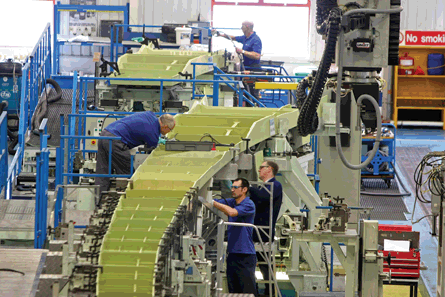Conveniently, 2009 was bracketed by two stories that outline the outsourcing and supply chain challenge facing big civil aerospace in 2010.
In January, Airbus sold its Filton wing components manufacturing operation to long-time supplier GKN. That £136 million ($218 million) deal was a key element in Airbus's Power8 cost-cutting scheme and propelled GKN into the ranks of major tier 1 suppliers, opening the way to further lucrative Airbus contracts as well as new, Filton-based business with other customers.
In December, Boeing bought out Alenia Aeronautica, its joint venture partner in the North Charleston, South Carolina Global Aeronautica operation that integrates Italian- and locally made 787 centre fuselage sections before aircraft final assembly.
Global Aeronautica started as a 50-50 787 supply venture between Vought and Alenia. But as 787 programme troubles grew Boeing decided it needed to increase oversight at North Charleston and bought Vought's half of the operation, in March.
Boeing later took its share of the site's operations to 75% by buying Vought's aft fuselage facility, and subsequently selected the location for a second 787 final assembly line, which will eventually supplement the main line at Everett.
 |
|---|
© GKNAirbus sold its Filton wing components manufacturing operation to long-time supplier GKN as part of its Power8 cost-cutting scheme |
The success and failure represented by these two episodes will shape airframer outsourcing strategies for the foreseeable future.
Filton was meant to be just one leg of a three-part outsourcing strategy for Airbus, which had intended to make similar sales of its French and German aerostructures operations, to Latécoère and MT Aerospace, respectively, which would, alongside GKN, become truly outsourced suppliers to the A350 and other future projects. The French and German sales failed, however, so those operations were spun off as wholly owned Airbus units. Aerolia and Premium Aerotec may ultimately win work from other customers, but for the time being their workload will most likely be all-Airbus.
GOING BACKWARDS
Boeing has meanwhile gone backwards. Its 787 grand plan called for radical engineering and a radical supply chain, but events have forced it to bring a big chunk back in-house.
Boeing's plan would appear to have fallen apart, but that would be much too hard an assessment. It is going to end up with a second assembly line, which a standard business-school analysis would regard as positive. By being geographically diverse, Boeing spreads several risks: labour shortage, labour unrest and disruption caused by weather or disasters like fire or terrorist attack.
Neither episode represents total success or total failure. But Airbus and Boeing have demonstrated the difficulty of transforming themselves into aircraft integrators that perform the engineering and final assembly while outsourcing intermediate production and detail engineering.
Looking ahead, Boeing will be the worse off. For the US behemoth, 2010 and the advent of 787 production may well throw up more hard choices between central control and outsourcing. Having made a bold move away from being a traditional all-under-one-roof aircraft maker, Boeing may have to decide how far back it goes.
Airbus is in the relatively enviable position of deciding how much outsourcing to do. If it can find more GKNs, good; if not, it carries on as is.
The lessons of these attempts at organising a 21st century airframer are not lost on a potential rival. Bombardier of Canada is developing its CSeries rival to the A320/737 narrowbody hegemony with what looks like a deft balance of in-house and outsourced work, including contributions from its Belfast outpost, which has to bid for work like any supplier.
Bombardier is attempting to carry off a project that is big enough to break the company. But by this time next year if it has not gone that far off track we may find that the future of organisational management is Canadian.
Source: Flight International























